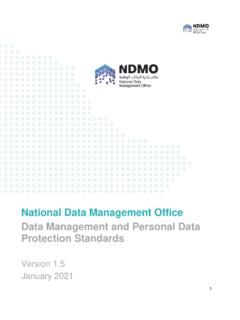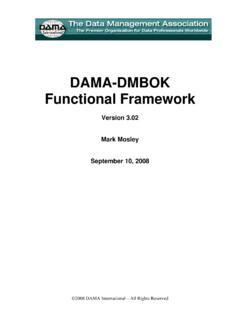Transcription of DAMA-DMBOK2 and CDMP - DAMA Phoenix
1 InternationalDAMA-DMBOK2 and CDMPS usan Earley DAMA-DMBOK2 Guide Production Editor, DAMA Dictionary EditorDAMA InternationalInternational dama international 2015 --All Rights ReservedAgendaThe DAMA-DMBOK2 data management OverviewEnvironmental ElementsKnowledge AreasAdditional TopicsICCP and Certification TestingDAMA-DMBOK2 PurposeThe DAMA-DMBOK2 Guide is intended to be a definitive introduction to data management as it currently exists. DAMA-DMBOK21. To build consensus for a generally applicable view of data management Knowledge To provide standard definitions for commonly used data management Knowledge Areas, deliverables, roles, and other To identify guiding principles for data To overview commonly accepted good practices, widely adopted methods and techniques, and significant alternative approaches, without reference to specific technology vendors or their To briefly identify common organizational and cultural To clarify the scope and boundaries of data To guide readers to additional resources for further Goals Certified and aspiring data management professionals.
2 Other IT professionals working with data management professionals. data stewards of all types. Executives with an interest in managing data as an enterprise asset. Knowledge workers developing an appreciation of data as an enterprise asset. Consultants assessing and helping improve client data management Knowledge Areas. Educators responsible for developing and delivering a data management curriculum. Researchers in the field of data Audience Informing a diverse audience about the nature and importance of data management . Helping standardize terms and their meanings within the data management community. Helping data stewards and data management professionals understand their roles and responsibilities. Providing the basis for assessments of data management effectiveness and maturity. Guiding efforts to implement and improve their data management Knowledge Area. Pointing readers to additional sources of knowledge about data management .
3 Guiding the development and delivery of data management curriculum content for higher education. Suggesting areas of further research in the field of data management . Helping data management professionals prepare for CDMP and CBIP UsesOther BOK Guides A Guide to the Project management body of Knowledge (PMBOK Guide), published by the Project management Institute (PMI ). PMI is a professional organization for project managers. A Guide to the Software Engineering body of Knowledge (SWEBOK), published by the Institute of Electrical and Electronic Engineers (IEEE). A Guide to the Enterprise Information Technology body of Knowledge (EITBOK), soon to be available as a wiki, published by IEEE. The Business Analysis body of Knowledge (BABOK), published by the international Institute of Business Analysis (IIBA). The Common body of Knowledge (CBK) published by the international Information Systems Security Certification Consortium ((ISC).)
4 The Canadian Information Technology body of Knowledge (CITBOK) is a project undertaken by the Canadian Information Processing Society (CIPS) to outline the knowledge required of a Canadian Information Technology wheels 11 data ManagementKnowledge Areas7 EnvironmentalElementsGoals and Principles: The directional business goals of each knowledge area and the fundamental principles that guideperformance of each Knowledge also include Metrics to measure success. data management Program Metrics data Value Metrics data Quality Metrics Environmental ElementsActivities: Each knowledge area is composed of lower level activities. Some activities are grouped into sub-activities. Activities are further decomposed into tasks and Modeling and Storage and and Master Warehousing and Business Integration and and QualityEnvironmental ElementsDeliverables: The information and physical databases and documents created as interim and final outputs of each knowledgearea.
5 Some deliverables are essential, some are generally recommended, and others are optional depending on circumstances. data Strategy data Architecture data Services Databases data , Information, Knowledge, and WisdomEnvironmental ElementsRoles and Responsibilities: The business and IT roles involved in performing and supervising the knowledge area , and the specific responsibilities of each role in that knowledge area. Some roles will participate in multiple Knowledge ElementsSuppliersProvide input into the ActivitiesResponsiblePerforms the ActivitiesConsumersConsumes output from the ActivitiesStakeholderHas an interest in, or gains a benefit from, the ActivitiesPractices and Techniques: Common and popular methods and procedures used to perform the processes and produce the deliverables. Practices and Techniques include common conventions, best practice recommendations, and alternative approaches without ElementsToolsets: Categories of supporting technology (primarily software tools), standards and protocols, product selection criteria and common learning curves.
6 In accordance with dama international policies, specific vendors or products are not mentioned. data Modeling Tools Database management Systems data Integration and Quality Tools Business Intelligence Tools Document management Tools Metadata Repository ToolsEnvironmental ElementsOrganization and Culture:Environmental Elements Authority and Empowerment. Shared Values and Beliefs. Expectations and Attitudes. Personal Style and Preference Differences. Cultural Rites, Rituals and Symbols. Organizational Heritage. Change management Recommendations. management Metrics measures of size, effort, time, cost, quality, effectiveness, productivity, success, and business value. Critical Success Factors. Reporting Structures. Contracting Strategies. Budgeting and Related Resource Allocation Issues. Teamwork and Group Areas (KAs) Modeling and Storage and and Master Warehousing and Business Integration and and QualityKnowledge AreasKnowledge Area ContextDefinition: Context DiagramGoals: 1.
7 Measurable desired outcomes from ActivitiesActivities:1. data Governance2. data Architecture3. data Modeling and Design4. data Storage and Operations5. data Security6. data Integration and Interoperability7. Records and Content8. Reference and Master Data9. data Warehousing and Business Intelligence10. Metadata11. data QualityInputs:Existing orRequirements for Rules Standards Regulations Models data Metadata (outputs from other KAs)Deliverables:New or Updated Procedures Rules Standards Models data Metadata (inputs to other KAs)OutputsBusiness DriversInputsTechnical DriversSupplier Roles: Defined Roles that supply or provide the Roles: Defined Roles that Perform the Activities Consumer Roles: Defined Roles that receive and use the Roles: Defined Roles invested in achieving : Defined measurements that can be compared to expectations to determine success of the : Classes of Software used to perform or manage ActivitiesTechniques: Defined Procedures or Techniques used to perform Activities with good successGoals are measured by MetricsSuppliers Deliver InputsConsumers Receive DeliverablesStakeholders benefit from achieving GoalsDefinition What is the Knowledge Area?
8 Goals What does the Knowledge Area accomplish? Why does the Knowledge Area exist?Activities What are the Knowledge Area s tasks that accomplish the goals? Inputs What do the Knowledge Area s tasks use?Suppliers Who provides the inputs to the Knowledge Area s tasks?Responsible Who is performs the Knowledge Area?Tools What tools do the Knowledge Area s tasks use?Deliverables What does the Knowledge Area deliver?Consumers Who uses the primary deliverables?Stakeholders Who has an interest in the Knowledge Area s success?Metrics What is used to measure the Knowledge Area s success?Note: no where, how, whenKnowledge Area ContextActivity Groups: Each activity belongs to one of four Activity Groups: Planning Activities (P) Activities that set the strategic and tactical course for other data management activities. Planning activities may be performed on a recurring basis. Development Activities (D) Activities undertaken within implementation projects and recognized as part of the systems development lifecycle (SDLC), and creating data deliverables through analysis, design, building, testing, preparation, and deployment.
9 Control Activities (C) Supervisory activities performed on an on-going basis. Operational Activities (O) Service and support activities performed on an on-going GroupsData management OverviewData ManagementDefinition: The planning, execution and oversight of policies, practices and projects that acquire, control, protect, deliver, and enhance the value of data and information assets. Mission: To meet the data availability, quality, and security needs of all :1. To understand the information needs of the enterprise and all its To capture, store, protect and ensure the integrity of data To continually improve the quality of data and information, including: data accuracy. data integrity. data integration. The timeliness of data capture and presentation. The relevance and usefulness of data . The clarity and shared acceptance of data To ensure privacy and confidentiality, and to prevent unauthorized orinappropriate use of data and To maximize the effective use and value of data and information assets, by Controlling the cost of data management .
10 Promoting a wider and deeper understanding of the value of data assets. Managing information consistently across the enterprise. Aligning data management efforts and technology with business ManagementGuiding Principles1. data and information are valuable enterprise Manage data and information carefully, like any other asset, by ensuring adequate quality, security, integrity, protection, availability, understanding, and effective Share responsibility for data management between business data stewards (trustees of data assets) and data management professionals (expert custodians of data assets).4. data management is a business Knowledge Area and a set of related data management is also an emerging and maturing profession with the IT ManagementData ManagementDefinition: The planning, execution and oversight of policies, practices and projects that acquire, control, protect, deliver, and enhance the value of data and information assets.

